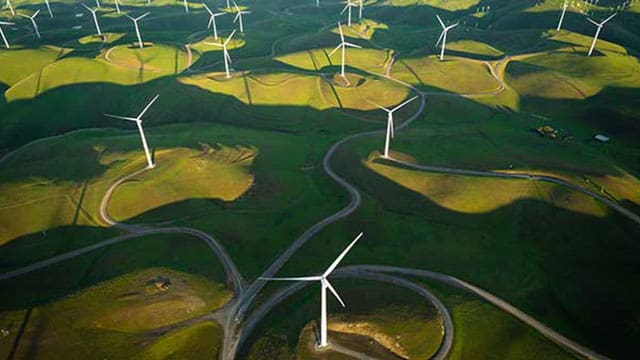There is no chance that the B.C. government’s ambitious wind power target can be achieved by 2030
By Denise Mullen
and Jock Finlayson
Energy is the universal currency. It is central to economic and human development. Not having reliable energy – or only having energy that is too expensive – undermines well-being.
Today, we produce and consume large quantities of various fuels in a vast, interconnected global energy system. Although it meets only about 17 percent of total energy demand (both globally, in Canada and B.C.), electricity is a vital part of that energy system. The electricity subsector is also a major focus for governments looking for ways to reduce greenhouse gas emissions, including by adding large amounts of intermittent wind and solar to existing electricity systems.
 Denise Mullen |
 Jock Finlayson |
Wind is an increasingly important source of electricity. However, on a global scale, it satisfies only a tiny fraction of total worldwide energy demand. The same is true in B.C.
Electricity is a secondary source of energy, meaning it’s derived from something else – coal, natural gas – and “renewables”: uranium, water, wind, sun, and biomass. The electrons produced from “renewables” are GHG-free, which is appealing, but the processes and machinery used in generating and transmitting electricity are not.
Electricity is an instantaneous resource where supply and demand must always be in balance, requiring real-time, 24-hours-a-day monitoring and control. Absent storage, all electricity generated must be used when it’s produced. An entire electricity system composed of wind and solar is not possible with available technologies.
Currently, wind power projects in B.C. produce about 2.2 TWh (terawatts) of electricity from 747 MW (megawatts) of installed capacity. The NDP government’s CleanBC Roadmap has set a target of 7.8 TWh of wind power by 2030. This means expanding the current B.C. wind generation supply by 3.5 times in a little over five years – a herculean undertaking.
To deliver on the government’s pledge, B.C. Hydro is seeking 3,000 GWh (or three TWh) of “new clean or renewable generation capability” by late 2028. Anticipation of this Call for Power has been high for some time. The quantity of electricity sought is equivalent to about 10 projects the size of the existing Cape Scott wind facility, which has a capacity of approximately 99 MW and generates approximately 316 GWh of output per year. This is a very fast turnaround, considering the current collection of 10 existing wind projects across the province has taken almost two decades to build collectively.
So, is the government’s wind power goal achievable? We think not, for a few reasons.
Identifying appropriate locations to site wind turbines is a challenge. Sites must have sustained windy conditions and be environmentally and socially acceptable, with no impacts on protected areas and minimal impacts on local communities. B.C.’s rugged and varied terrain presents its own set of siting issues.
The engineering feat of ensuring that wind turbines are efficient and reliable and have the necessary transmission infrastructure adds another layer of complexity, one that policymakers rarely think about.
Our regulatory and utility procurement processes are complicated and lengthy. The average time for projects reviewed under the B.C. Environmental Assessment process is eight years. And under the 2018 version of the NDP’s Environmental Assessment Act, only one project has successfully navigated all the requirements.
Then, there are community considerations. The spatial impacts of wind can be significant, causing communities to be wary of accepting proposed increases in land use to produce any kind of electricity.
The capital required for all types of electricity projects – apart from very small ones – is substantial. A 100 MW wind project needs a large amount of private risk capital. This is an obstacle for many industries operating in B.C.
B.C. Hydro’s 25 percent Indigenous equity participation as a criterion for bidding in the 2024 Call for Power may also present a significant hurdle. Many Indigenous-owned or partnership projects are not utility-scale and, at present, are dominantly small hydroelectric. The latter are not eligible to bid, and there are no opportunities for these kinds of projects with the demise of B.C. Hydro’s Standing Offer program.
In short, we doubt that enough new wind power projects can be advanced in time to meet the government’s objective. So, by 2030, the province will find itself significantly short of the planned wind electricity target. This is clear to anyone other than a government communications officer charged with writing news releases.
B.C. should continue to develop new, cleaner sources of electricity generation, but not at any cost – and not based on unrealistic, politically manufactured timeframes.
Denise Mullen is Director of Environment, Sustainability and Indigenous Relations at the Business Council of British Columbia. Jock Finlayson is Chief Economist at the Independent Contractors and Businesses Association (ICBA), which is Canada’s largest construction industry association.
Explore more on Alternate energy, Eby government, BC politics
The opinions expressed by our columnists and contributors are theirs alone and do not inherently or expressly reflect the views of our publication.
Troy Media
Troy Media is an editorial content provider to media outlets and its own hosted community news outlets across Canada.



